The social distance imposed by the pandemic has me longing for the holidays and the warmth and goodness of home-cooked favorites. Growing up in Baton Rouge, Louisiana, there was one dish that my mother Wessie always included in both Thanksgiving and Christmas dinner – baked cushaw.
The holiday dinner menu was classic American – turkey, cornbread dressing, cranberry sauce, yams, various green vegetables, congealed salad, freshly toasted salted pecans, and the family favorite cushaw made sweet and scrumptious with sugar, eggs, butter, vanilla and nutmeg. (I’ll share the basic recipe later.)
Cushaw is a green-and-white-striped longneck squash (Cucurbita argyrosperma; synonym C. mixta). If you are not familiar with it, you still may have seen a cushaw in among the gourds and squashes sold for fall decorating.
Cucurbits are members of the gourd family (Cucurbitaceae) that include squash, pumpkins, melons and bitter melons, cucumbers, and gourds. Cucurbita is the genus that includes five domesticated species that give us most of the fruits we call winter squash. They are “good keepers,” as we say in the South, holding up well for months in cool storage.
Cushaw is said to come originally from southern Mexico and/or the West Indies, but has made its way north to become part of the traditional foodways of Arizona’s Sonoran Desert, Appalachian Tennessee, and Kentucky. Because of its delicious tender flesh (my theory) it worked its way into the French-Spanish-Indian-African cuisine of Creole Louisiana. It is a native American plant so maybe the Indians of Southeast Louisiana introduced the African and European settlers to it.
My mother prized cushaw for holiday meals. But she wasn’t the only one. Abraham Lincoln’s family brought cushaw seeds with them when they moved from Kentucky to Indiana and then on to Illinois. Today Lincoln’s Indiana Boyhood Home in Lincoln City still grows the heirloom squash from seed originally brought to Indiana by Abe’s father Thomas. The park even puts on an annual cushaw festival every October.
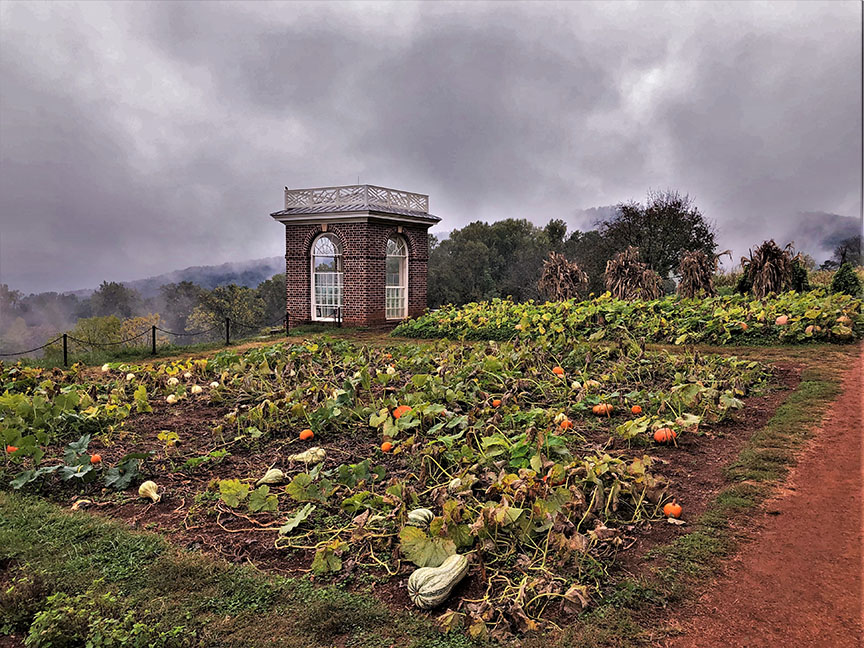
Cushaw is also grown at Monticello in in Virginia where Thomas Jefferson may have grown it in his big vegetable garden. Peggy Cornett, Curator of Plants at Monticello, says that, while it’s not known if the green striped cushaw was cultivated at Monticello, Thomas Jefferson documented numerous squashes including long crooked winter squash, cymling (pattypan), upper ground sweet potato winter squash, and warted summer squash. The green-striped cushaw is a perennial favorite in the Monticello gardens today.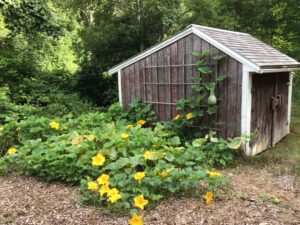
I have also grown it in New England where it seems to do just fine. If you grow it, please give it plenty of room, just like growing pumpkins. The vines are lovely with big white-spotted leaves – like stars in the night sky – and deep yellow-orange flowers that are good to stuff with herbed ricotta and bake or fry. It takes ten to twelve weeks for fruits to mature.
They will be all different sizes and shapes, but count on at least a few fruits being big boys. I just measured my champion: It’s 32-inches long and 25-inches in diameter and weighs eleven pounds.
To cook it I’ve found it’s easiest to slice it into chunks, remove the seeds, and bake it face-down in a half-inch of water in a deep roasting pan for about an hour at 350° F. When fully cooked it scoops easily out of the shell. That is much simpler than trying to peel it.
Baton Rouge’s most famous cookbook is River Road Recipes created by the capital city’s Junior League. That book was published in 1959 and is in its 80th printing. It has sold more than a million copies. Well, here’s a good baked cushaw recipe from that illustrious cookbook:
I mash the squash with a fork before mixing it all together. Baking usually takes an hour or more. But talk about good!
Happy holidays!

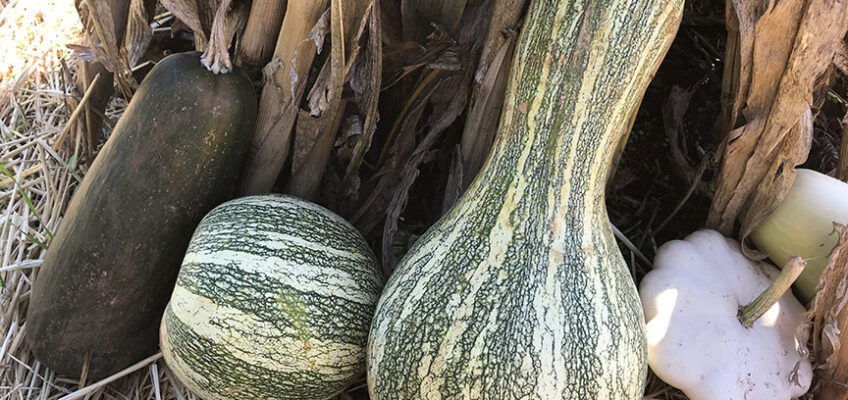
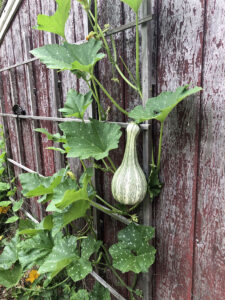
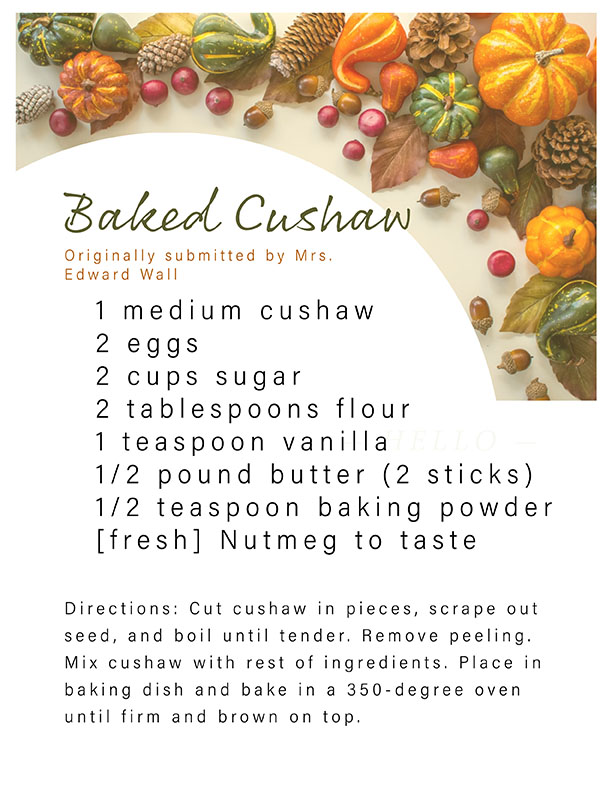
Mary Anne Pickens
Thank you for this wonderful article, Randy! I have never eaten a cushaw, but I love the history behind any plant and now I am curious about this one!
Margaret D Tyler
I can just smell this cooking right now! I will have to go to the Framer’s Market tomorrow and buy a cushaw. Thank you Randy for this inspiring story. I will definitely add this to my garden and also to my Thanksgiving table.
Susan Haltom
Hey, Mary Anne! And thank you, Randy, for this personal, educational, entertaining, and mouth-watering article. Well done, and I send thanks to you and the SGHS Board for keeping interesting articles coming on the website landing page. I didn’t realize that I could reply or comment on articles until I saw Mary Anne’s.
William C. Welch
Randy, I thoroughly enjoyed your article on cushaw! I learned to appreciate it in Louisiana but haven’t had any in a while. We have a local store that probably has it. Beautiful day here in College Station. Bill
Dak McInnis
Upon moving to Baton Rouge, Louisiana, I had the privilege of meeting the author, Randy Harelson, who eventually introduced me to the cushaw, which I had never heard of nor much less eaten. My curiosity regarding this giant gourd plus Randy’s enthusiasm for horticulture, family tradition, and good eats demanded I give it a try. Following precisely the recommended recipe, the cushaw was baked and with the pomp of a debutante, presented at our Thanksgiving table. Reception was met with delicious approval and this not-so-humble member of the native squash family endeared itself to the hungry members of mine. It is a memorable dish. Loved your informative article!
Stephen Poulakos
The Gourd Garden of old Seagrove lives on! Thank you for sharing this delightful memory of your mother Miss Wessie. It is great to hear to “roots” of the Cushaw. Now we know!
Greg LaCour
Randy! A great reminder of a childhood favorite! I will be cooking Cushaw for Christmas! Come home soon!
CW Rhymes
Recently my aunt surprised me with baked cushaw. We live in central and SE Louisiana. It was a childhood favorite of mine that my grandmother grew in her garden, and made frequently. I was trying to teach a friend about cushaw so I googled it for her to see a picture, and came across your informative article.
The franchise grocery stores don’t usually carry them so you have to get them from someone selling them on the side of the road nowadays. This is what my aunt did, then she referred to her very used copy of River Road Cookbook: The Textbook of Louisiana Cuisine so she’d make sure she had the recipe right.
OMG it was SO good, and the children, who had never eaten it before, wanted to know if she would make it all the time. Why wait for the holidays. It’s good anytime – all the time.
Toni Lovern
Thank you for this information. I grew many different squash this year. My friend gave me a whopper Cushaw. It was 21.1 lbs. I was able to get 10lbs of mashed and cubed flesh from it to freeze. I love this page and will be looking into acquiring a copy of the cookbook you mentioned.
Gene Owens
I grew up in Eastern NC eating cushaw (We spelled it kershaw). Peeled, cut boiled until tender. We freeze a large quantity each year. After cooking we place it in a callender and drain well. Then package in 2 or 4 cup freezer bags for use in cakes, pies or pudding.